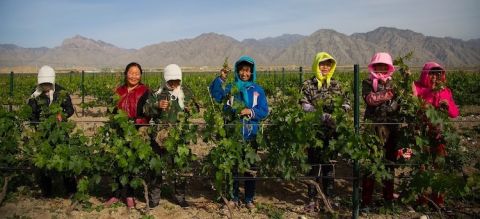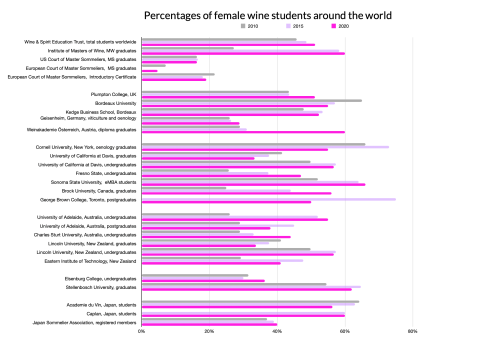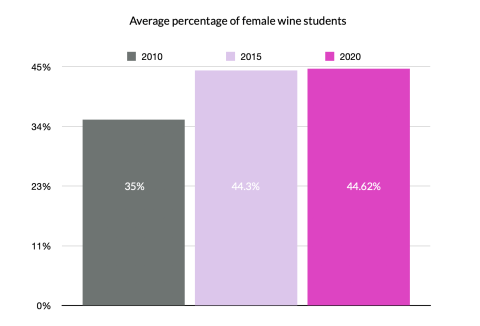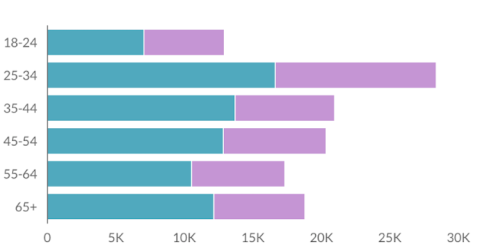Where have women got to in wine?
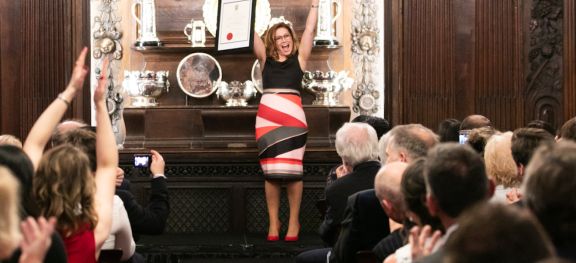
9 March 2021 We have now been able to update the statistics for female wine students at the two relevant Australian universities.
8 March 2021 As well as publishing a video of an hour-long discussion between COVID-stressed women in wine and an account of prominent Portuguese wine women with links to several pertinent webinars, we try to quantify women's progress. Above, Almudena Alberca celebrates being presented with her MW certificate in Vintners' Hall.
On this International Women’s Day we thought we would look at how important women are today in various spheres of wine-related activity that are easiest to measure. (It would have been interesting, for instance, to audit the number or proportion of female winemakers throughout the world, but that would be a major, long-term project.)
I think we can all agree that women are slowly assuming more prominence in the wine world. They have always been there in the back offices, in the worst-paid jobs such as vineyard work as shown here in Ningxia, but it is no longer unusual to come across wine buyers, salespeople, sommeliers, technicians, commentators, educators, winemakers and even viticulturists who are female. Here in the UK in this century there have been some really quite high-profile women in the wine business. In the US Barbara Banke runs the multinational Jackson Family Wines with an admirable accent on sustainability, and wine industry veteran Terry Wheatley, president of Vintage Wine Estates, is about to become the first woman to take a major, multi-hundred-million-dollar wine-producing group public. Overall, however, the US wine scene is decidedly male.
And I was brought up short last week when I looked down the list of signatories to a recent letter coordinated by David Gleave MW of Liberty Wines to the UK government about post-Brexit bureaucracy from almost all of the most important wine importers.
Of the 52 senior executives, a mere four companies – Accolade Europe, Les Caves de Pyrène, Matthew Clarke and North South Wines – have women at the helm. In this day and age, as they say, particularly when all scientific studies suggest that women are better at tasting than men, this proportion, under 8%, is truly pathetic.
The proportion of women studying wine, on the other hand, seems to be much healthier. Masters of Wine, Master Sommeliers and various educational bodies have kindly provided statistics for us for 2010, 2015 and 2020 to enable us to monitor trends.
The chart above showing the proportion of women either studying at or graduating from various student bodies suggests that in very general terms it is increasing. The number of bars that reach at least 50% to reflect the proportion of women in the population is definitely greater in 2020 (the shocking-pink bars) than in 2010 (the grey ones). If any figures are missing in the chart above, it’s because the institution simply doesn’t have the relevant figures available. And occasionally we have used 2019 figures for educational bodies who don’t yet have 2020 figures available.
The WSET figures are perhaps the most revealing because they are based on the greatest number of students, more than 100,000 around the globe. Based on my annual presence at the WSET Diploma awards ceremony in London, attended by successful students from around the world, I would definitely say that a very high proportion of the top awards go to women nowadays.
The two most famous wine qualifications, MW and MS, appear below the WSET in our chart because they too are global in their reach – even if the Master Sommelier qualification is administered by two very distinct ‘Courts’, one for the Americas and another, based in Europe, for the rest of the world. The number of new MWs and MSs each year is relatively low, sometimes a single-digit figure, which can result in dramatic changes in percentages. In 2015, for instance, not a single person qualified as an MS outside the US. And, while the proportion of women who qualify as an MW, like the triumphant Almudena Alberca MW (pictured above) of Spain, continues to grow healthily, the same cannot be said about new female MSs – perhaps partly because of the shameful sexual harassment in the troubled recent history of the US Court. It is to be hoped that the new, all-female team running the US Court will effect real change.
Below these qualifications in the chart we examine some of the leading educational institutions in Europe, then those in North America followed by Australia and New Zealand, South Africa and finally Japan. Our researcher initially underestimated the proportion of female wine students at Australia’s centre of wine academe, the University of Adelaide, but we have now corrected this and have now been able to add the relevant statistics from Australia’s other major wine faculty, at Charles Sturt University in Wagga Wagga. It is notable, incidentally, how keen Japanese women seem to be to study wine. (Note that the Japan Sommelier Association has nothing directly to do with professional sommeliers but is instead a group of people interested in wine.)
By taking an average of the percentages for each year, we have come up with the very approximate overview below, which at least suggests that women are making more impact in terms of the total number of wine students.
When such quantification is possible, there are signs that the pass rate for women is higher than for men. Sybille Troubleyn of WineWise, the leading wine educator in Belgium, is probably quite representative when she reports that there has definitely been more interest in wine education among women in the last 10 years. But it’s a bit more nuanced than that. ‘An interesting thing is that we offer WSET at all levels in Belgium and we have more ladies in the lower levels (1 and 2), but the male students continue to the higher levels. Female students hesitate for Level 3 and definitely for level 4 Diploma they hesitate to start. Only a third of Diploma students in Belgium are female. Although once they go for it, they have good results and finish faster.’ It may well be that, as in so many other areas of life, many women are held back by the demands of family life and childcare.
Back home we have some figures on how current visitors to JancisRobinson.com split by gender and age group. What’s heartening is that the proportion of women visitors is greater among young people, auguring well for the future.
You can see that those between 25 and 34 represent the biggest single age group of visitors to this website, and that among them, the proportion of women is highest. These are visitors, not members, so perhaps the numbers are boosted by the extent to which this age group lives online.
As for members of our Purple Pages, the proportion of women is slowly increasing, I’m delighted to say, but it is still under 20%. I’d love to see it growing further. After all, isn’t this site, bearing the name of one of the better-known female wine writers, with a plethora of talented women on the team, a natural home for female wine enthusiasts?
Become a member to view this article and thousands more!
- 15,409 featured articles
- 275,056 wine reviews
- Maps from The World Atlas of Wine, 8th edition (RRP £50)
- The Oxford Companion to Wine, 5th edition (RRP £50)
- Members’ forum
- 15,409 featured articles
- 275,056 wine reviews
- Maps from The World Atlas of Wine, 8th edition (RRP £50)
- The Oxford Companion to Wine, 5th edition (RRP £50)
- Members’ forum
- 48-hour preview of all scheduled articles
- Commercial use of our wine reviews

